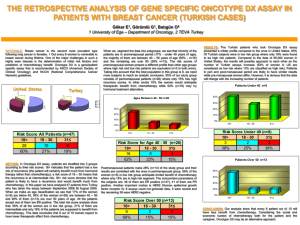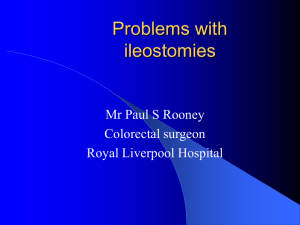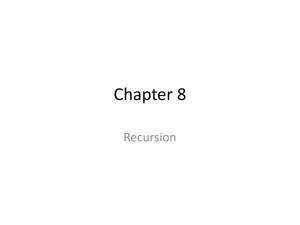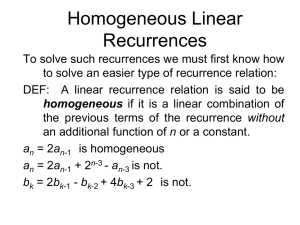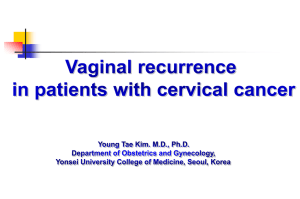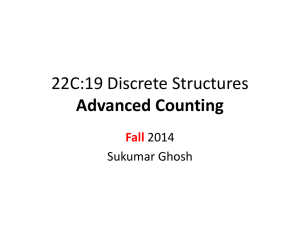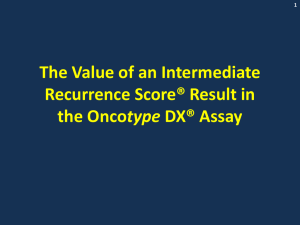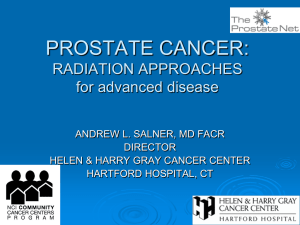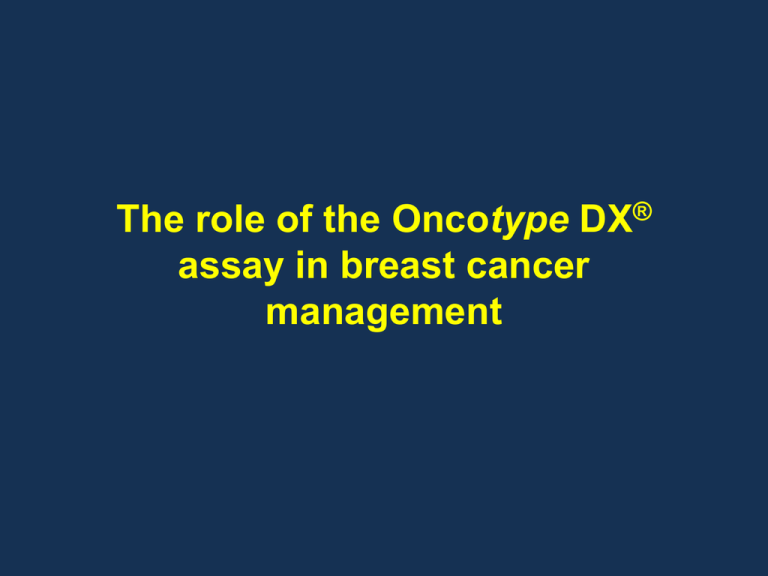
The role of the Oncotype DX®
assay in breast cancer
management
Objectives
• Brief overview of the Oncotype DX® assay and reports
• Review assay development strategy and supporting studies
– Technical feasibility studies
– Gene discovery and refinement studies
– Analytical validation studies
• Review clinical validation studies in women with breast cancer
– Prognostic studies
– Predictive studies
• Discuss future development plans
2
Case study presentation
• A 55-year-old post-menopausal woman presents
with an infiltrating ductal carcinoma
–
–
–
–
–
Tumor size 1.0 cm
ER/PR IHC positive
HER2 IHC negative
Sentinel lymph node negative
Excellent overall health
How should this patient be evaluated for treatment?
What is her risk of disease recurrence?
How likely is she to benefit from hormonal or chemotherapy?
3
Breast cancer treatment
in the United States (2009)
• Approximately 110,000 women with ER+,
lymph node-negative breast cancer are
diagnosed annually in the United States
– This represents ~50% of newly diagnosed
patients today
– Many women are offered chemotherapy,
but all do not receive substantial benefit
Better identification of disease markers is needed
to help make therapeutic decisions
4
Prognostic & predictive markers utilized
in breast cancer management
Prognostic (recurrence risk)
Predictive (treatment benefit)
•
•
•
•
•
•
•
•
• ER/PR status
• HER2 neu status
• Oncotype DX® test
Axillary node status
Histologic type/grade
Tumor size
Patient age
Lymphatic/Vascular invasion
ER/PR status
HER2 neu status
Oncotype DX® test
These markers can be
used to estimate the risk
of disease recurrence
Cianfrocca and Goldstein. Oncologist. 2004;9(6):606-616;
Lonning PE. Ann Oncol. 2007;18(suppl 8):viii3-viii7.
These markers can be
used to predict
treatment benefit
5
The Oncotype DX® assay
• Quantitatively predicts the likelihood of breast cancer
recurrence in women with newly diagnosed, early stage,
ER+ invasive breast cancer
• Assesses the likely benefit from both hormonal therapy
and chemotherapy
• Is recommended by both ASCO and NCCN clinical
practice guidelines
Harris L, et al. J Clin Oncol. 2007;33(25):5287-5312.
NCCN, National Comprehensive Cancer Network
Adapted from NCCN Practice Guidelines in Oncology – v.1.2010
6
Oncotype DX® Report Samples
• Oncotype DX report provides
valuable information on:
– Clinical prognosis
– Predicted chemotherapy
benefit
– Quantitative data on
ER / PR / HER2
• Node positive report contains
an additional page with
prognosis and predicted
chemo benefit information
specific to node-positive
patients
7
Oncotype DX® Technology
Development Overview
Technical Feasibility
2001
Gene Discovery & Refinement
2002
Analytical Validation
2002
Clinical Validation (prognostic)
2004
Clinical Validation (predictive)
2005
8
Oncotype DX® Technology
Development Overview
Technical Feasibility
Gene Discovery & Refinement
Analytical Validation
Clinical Validation (prognostic)
Clinical Validation (predictive)
9
Purpose of
technical feasibility studies
Technical feasibility studies were designed to assess:
• RNA yield and the quality of RNA after extraction from FPET
tissues
• Gene expression differences and similarities between whole
section and enriched tumor tissue sections
– To establish criteria for manual microdissection
• Gene expression heterogeneity within breast tumor tissues
– Assess within block and between block gene expression
heterogeneity
• Selection of reference genes (important for normalization of
pre-analytical factors)
– Delay to fixation, duration of fixation, fixative
10
Importance of
manual microdissection
Example from study of 16 breast
cancer blocks for ER expression
14
• Most cases show minimal
differences in ER expression
between WS and ET
ER Whole Section
ER
12
• Some tumors contain
significant amounts of nontumor elements (e.g., biopsy
cavities, skin, smooth
muscle) which require
manual microdissection
r = 0.73, p = 0.001
10
8
6
4
2
0
0
2
4
6
8
10
12
14
ER Enriched Tumor
ER = estrogen receptor
Differences in non-tumor tissue may impact single gene assessment
• Thus, if < 50% invasive
carcinoma, manual
microdissection is always
performed
11
Evaluation of tumor gene
expression heterogeneity
Example of the differences in gene expression within &
among 3 FPET blocks from two patients
3 Blocks from spatially distinct tumor regions
Block
1
2
ER/PR/HER2 IHC Status
H&E
ER+
PR+
HER2–
3
• The three FPET blocks were step sectioned at five different levels
• Quantitative RT-PCR was performed on all 15 samples
Poster presented at: United States-Canadian Academy of Pathology 93rd Annual Meeting;
March, 2004; Vancouver, British Columbia.
12
Importance of standardized quantitative
measurement using RT-PCR:
Expression by RT-PCR
(relative to reference genes)
Expression by RT-PCR
(relative to reference genes)
minimal gene expression heterogeneity within & among tumor blocks
Reproducibility
• Within block expression: standard deviation < 0.5 normalized expression units
• Among block expression: standard deviation < 1.0 normalized expression units
Poster presented at: United States-Canadian Academy of Pathology 93rd Annual Meeting;
March, 2004; Vancouver, British Columbia.
13
Oncotype DX® Technology
Development Overview
Technical Feasibility
Gene Discovery & Refinement
Analytical Validation
Clinical Validation (prognostic)
Clinical Validation (predictive)
14
Oncotype DX® gene panel was developed
from clinical trial evidence
• 250 cancer-related genes were selected
• Genes were analyzed for expression and relapse-free interval
correlations across 3 independent studies of 447 breast cancer patients
N
Node status
ER
status
Treatment
NSABP B-20, Pittsburgh, PA
233
N–
ER+
Tamoxifen (100%)
Rush University, Chicago, IL
78
≥ 10 positive
nodes
ER+/–
Tamoxifen (54%)
Chemotherapy (80%)
Providence St. Joseph’s Hospital,
Burbank, CA
136
N+/–
ER+/–
Tamoxifen (41%)
Chemotherapy (39%)
Study site
From these studies, 21 genes were selected
Paik et al. SABCS 2003. Abstract #16.
Cobleigh et al. Clin Cancer Res. 2005;11(24 Pt 1):8623-8631.
Esteban et al. Proc ASCO 2003. Abstract #3416.
15
Oncotype DX® Recurrence Score® result:
calculated from 21 different genes
16 CANCER RELATED GENES
Estrogen
Proliferation
HER2
Invasion
Others
ER
PR
Bcl2
SCUBE2
Ki-67
STK15
Survivin
Cyclin B1
MYBL2
GRB7
HER2
Stromelysin 3
Cathepsin L2
CD68
GSTM1
BAG1
5 REFERENCE GENES
Beta-actin
GAPDH
RPLPO
GUS
TFRC
16
Paik et al. N Engl J Med. 2004;351:2817-2826.
Oncotype DX® Recurrence Score® result
calculation and risk categories
Recurrence Score =
+ 0.47 × HER2 Group Score
– 0.34 × Estrogen Group Score
+ 1.04 × Proliferation Group Score
+ 0.10 × Invasion Group Score
+ 0.05 × CD68
– 0.08 × GSTM1
– 0.07 × BAG1
Risk group
Recurrence Score
Low risk
< 18
Intermediate risk
18 - 30
High risk
≥ 31
17
Paik et al. N Engl J Med. 2004;351:2817-2826.
The Oncotype DX® Recurrence Score® result is
a continuous predictor of recurrence risk
Distant recurrence at 10 years
What is the 10-year probability of distant recurrence
LOWER RISK
HIGHER RISK
for a patient with a Recurrence Score of 30?
40%
35%
30%
25%
20%
15%
Recurrence Score 30 =
20% risk of distant
recurrence at
10 years
10%
5%
0%
0
5
Dotted lines represent 95% CI
10
15
20
25
30
Recurrence Score
35
40
45
50
18
Oncotype DX® Technology
Development Overview
Technical Feasibility
Gene Discovery & Refinement
Analytical Validation
Clinical Validation (prognostic)
Clinical Validation (predictive)
19
The Oncotype DX® assay is analytically
validated
Analytical validation is the assessment of assay
performance characteristics and the optimal conditions to
generate accuracy, precision and reproducibility
Elements of analytic validation
• Analytical sensitivity
(limits of detection and quantitation)
• Assay precision and linear dynamic range
• Analytical reproducibility
• PCR amplification efficiency
• Sample and reagent stability
• Reagent calibration
• Instrument validation and calibration
20
Chau CH, et al. Clin Cancer Res. 2008;14(19):5967-5976.
Oncotype DX® uses RT-PCR technology
Reporter
Forward
Primer
R
Probe
Quencher
Q
Polymerization
Reverse
Primer
R
Q
Strand displacement
and cleavage of probe
• RT-PCR provides > 65,000fold range of measurement
– Maximizes ability to
discriminate the full range of
gene expression differences
among individual samples
• RT-PCR reactions can be
repeated with high
quantitative precision
– Provides required reliability for
individualized reporting
Q
R
Polymerization
completion
and signal detection
• RT-PCR works well with
RNA from formalin-fixed
paraffin-embedded tissue
21
Cronin M, et al. Am J Pathol. 2004;164:35-42.
Oncotype DX® assay process
• Standardized RT-PCR
– Optimized for the small
RNA fragments extracted
from fixed paraffin
embedded tissue (FPET)
– Optimized to be robust with
regard to sources of preanalytic variability such as
•
•
•
•
Delay to fixation
Duration of fixation
Fixative type
Sample age
22
Cronin et al. Am J Pathol. 2004;164:35-42
Normalization accounts for
all sources of pre-analytic variability
Hollandes
• Delays to fixation,
duration of fixation,
different fixatives and
sample age can affect
RNA quality
• Reference normalization
compensates for these
differences in sample
processing and sample
age
Formalin
23
Oncotype DX® assay process steps
1) PRE-ANALYTIC
– Pathology review of the FPET sample by a Board Certified Anatomic
Pathologist with Breast Expertise
– Determine whether manual microdissection for tumor enrichment is
required (~40% of submissions are microdissected for tumor
enrichment)
2) ANALYTIC
–
–
–
–
–
RNA extraction and quantitation (RiboGreen® method)
qPCR test for residual genomic DNA
Reverse transcription
TaqMan PCR
Data quality control
3) POST-ANALYTIC
– Calculation of Recurrence Score® result
– Report preparation and approval
24
Pre-analytic processing:
all FPET blocks are bar-coded before entering histology
25
Pre-analytic processing:
all tumors assessed by surgical pathologists with breast expertise
Pathology review to assess:
• Is tumor present?
• Is there sufficient tumor?
26
Patient samples are barcode tracked
from submission to report
27
Automation is central to
laboratory processes
28
Patient sample tracking:
LIMS bar-coding integrates reagents and robots for tracking and process control
Patient
FPET sample
RNA
extraction
96-well
96-well
Plate
96-well
Plate
96-well
Plate
Plate
SARP
GEMTools
Primers
Pool
Material
manager
Reverse
primer pool
QPCR
master mix
Material
manager
Oligo
plate assembly
96-well
plate
Probe
Reverse transcription
cDNA plates
384-well
plate
QPCR
reaction plate
Assay detection system
Tecan Robotics
Plate layout template and assembly for
primers and samples
29
Patient report delivery:
automated output and delivery
Print
FedEx
Report
distribution
service
E-mail
Fax
Web
PDF report
w/ electronic signature approval
30
Oncotype DX® Technology
Development Overview
Technical Feasibility
Gene Discovery & Refinement
Analytical Validation
Clinical Validation (prognostic)
Clinical Validation (predictive)
31
Clinical validation of Oncotype DX®
breast cancer assay
in node-negative disease
Oncotype DX® clinical validation:
NSABP B-14
• Objective: Prospectively validate Recurrence Score®
result as predictor of distant recurrence in nodenegative, ER+ patients
Placebo—not eligible
Randomized
Registered
Tamoxifen—eligible
Tamoxifen—eligible
• Multicenter study with prespecified 21-gene assay,
algorithm, endpoints, analysis plan
33
Paik S, et al. N Engl J Med. 2004;351:2817-2826.
Oncotype DX® clinical validation:
Proportion without distant recurrence
NSABP B-14, Distant Recurrence
Distant recurrence over time
100%
10-Year rate of recurrence = 6.8%*
90%
95% CI: 4.0%, 9.6%
80%
10-Year rate of recurrence = 14.3%
70%
95% CI: 8.3%, 20.3%
60%
10-Year rate of recurrence = 30.5%*
95% CI: 23.6%, 37.4%
50%
40%
All Patients, n = 668
30%
RS < 18, n = 338
20%
RS 18-30, n = 149
10%
RS ≥ 31, n = 181
P < 0.001
0%
0
2
4
RS, Recurrence Score® result
6
8
10
12
16
Years
*10-Year distant recurrence comparison between low- and high-risk groups: P < 0.001
Paik S, et al. N Engl J Med. 2004;351:2817-2826.
14
34
Oncotype DX® assay
NSABP B-14 subgroup analysis
Oncotype DX® NSABP B-14: Recurrence
Score® result subgroups by tumor grade
All patients N = 668
Well
224
166
41
17
Moderate
296
139
80
77
All patients
Low risk (RS < 18)
Int risk (RS 18-30)
High risk (RS ≥ 31)
Poor
RS, Recurrence Score result
Paik S, et al. N Engl J Med. 2004;351:2817-2826.
148
33
28
87
20% 40% 60% 80% 100%
% Distant recurrence-free at 10 years
37
Oncotype DX® clinical validation:
conclusions, NSABP B-14
• Oncotype DX® Recurrence Score® result is validated as
a predictor of recurrence in node-negative, ER+ patients
• Oncotype DX Recurrence Score performance exceeds
standard measures (patient age, tumor size, and tumor
grade)
• Oncotype DX Recurrence Score result (based on tumor
gene expression) more accurately quantifies the risk of
distant recurrence than do the NCCN guidelines (based
on patient age, tumor size, and tumor grade)
38
Paik et al. N Engl J Med. 2004;351:2817-2826.
Oncotype DX® clinical validation:
the Kaiser Permanente study
Study design
Matched case-control
Study
population
(N = 4964)
Kaiser Permanente patients < 75 years old in 14
Northern California hospitals diagnosed with nodenegative breast cancer between 1985-1994, no
adjuvant chemotherapy
Cases: Deaths from BC (n = 220)
Controls: Randomly selected, matched on age, race,
diagnosis year, KP facility, tamoxifen (n = 570)
Data sources
Cancer registry, medical records, archived diagnostic
slides, and tumor blocks
39
Habel LA, et al. Breast Cancer Res. 2006;8(3):R25.
The Kaiser Permanente study:
risk of BC death at 10 years: ER+, Tam-treated patients
(Recurrence Score® group)
10-Year absolute risk1
Kaiser
10-Year absolute risk1
NSABP B-14
Low
2.8%
3.1%
Intermediate
10.7%
12.2%
High
15.5%
27.0%
Risk classification
1Based
on methods by Langholz and Borgan, Biometrics 1997;53:767-774.
•
The Recurrence Score result has now been shown to be strongly
associated with risk of breast cancer-specific mortality among nodenegative, ER+, Tam-treated patients participating in a clinical trial and
among similar patients from the community setting.
•
Results from our study suggest that combining Recurrence Score result,
tumor grade, and tumor size provides better risk classification than any one
of these factors alone.
40
Habel LA, et al. Breast Cancer Res. 2006;8(3):R25.
Oncotype DX® Technology
Development Overview
Technical Feasibility
Gene Discovery & Refinement
Analytical Validation
Clinical Validation (prognostic)
Clinical Validation (predictive)
41
Oncotype DX® clinical validation:
NSABP B-20
•
Objective: To determine the relationship between Recurrence Score®
value and chemotherapy benefit in node-negative, ER+ patients
Tam + MF
Randomized
Tam + CMF
Tam
•
Multicenter study with prespecified 21-gene assay, algorithm,
endpoints, analysis plan
42
Paik S, et al. J Clin Oncol. 2006;24:3726-3734.
High Recurrence Score® result correlates with
greater benefit from chemotherapy (NSABP B-20)
Proportion without distant recurrence
1.0
0.9
PATIENTS WITH HIGH RS
28% absolute benefit from
tamoxifen + chemotherapy
0.8
0.7
0.6
0.5
Tamoxifen + chemotherapy
Tamoxifen
424
227
33
31
P = 0.02
RS < 18
Tamoxifen + chemotherapy
Tamoxifen
218
135
8
4
P = 0.61
RS 18-30
Tamoxifen + chemotherapy
Tamoxifen
89
45
9
4
P = 0.39
RS ≥ 31
Tamoxifen + chemotherapy
Tamoxifen
117
47
13
18
0.3
0.1
0.0
0
Events
All patients
0.4
0.2
N
2
RS, Recurrence Score result
Paik S, et al. J Clin Oncol. 2006;24:3726-3734.
4
6
Years
8
10
4.4% absolute benefit from
tamoxifen + chemotherapy
P < 0.001
12
43
Recurrence Score® result can add prognostic
discrimination not always provided by traditional
prognostic factors
• Age
– 44% of patients < 40 years old had low Recurrence Score results
(ie, there is a large fraction of younger patients for whom
chemotherapy benefit may be minimal)
• Tumor size
– 46% of patients with large tumors (> 4 cm) had low Recurrence
Score results
– Some patients with small tumors (< 1 cm) had intermediate or
high Recurrence Score results
• Tumor grade
– Assessment by local pathologists revealed that, even for poorly
differentiated tumors, 36% of patients had low Recurrence Score
result
– Approximately 20% of poorly differentiated tumors still had a low
Recurrence Score result
45
Paik S, et al. J Clin Oncol. 2006;24:3726-3734.
NSABP B-20: Many younger patients have low
Recurrence Score® results
P=0.018
41%
24%
28%
19%
14%
21%
22%
21%
44%
55%
50%
60%
N=63
N=226
N=166
N=196
46
Paik S, et al. J Clin Oncol. 2006;24:3726-3734.
NSABP B-20: Many small tumors have
Intermediate to High Recurrence Score® values
P=0.001
Recurrence Score
100
80
60
40
20
16%
25%
30%
33%
20%
19%
23%
21%
64%
56%
46%
46%
0
N=110
≤1 cm
N=318
1.1 - 2 cm
N=196
2.1 - 4 cm
Clinical tumor size
Paik S, et al. J Clin Oncol. 2006;24:3726-3734.
N=24
>4 cm
47
NSABP B-20: Significant proportion of high-grade
tumors have low Recurrence Score® values
P<0.001
P<0.001
12%
22%
42%
5%
12%
61%
16%
22%
22%
12%
24%
19%
73%
56%
36%
83%
64%
19%
N=77
N=339
N=163
N=119
N=340
N=190
48
Paik S, et al. J Clin Oncol. 2006;24:3726-3734.
Tamoxifen benefit and the Oncotype DX® assay
NSABP B-14 tamoxifen benefit study in node-negative, ER+ patients
Placebo-eligible
Randomized
Tamoxifen-eligible
Objective: determine whether the Oncotype DX assay
provides information on
1) Prognosis (likelihood of recurrence)
2) Response to tamoxifen (change in likelihood of
recurrence with tamoxifen)
3) Both
49
Paik S, et al. N Engl J Med. 2004;351:2817-2826.
B-14 overall benefit of tamoxifen
Proportion without distant recurrence
All patients (N = 645)
1.0
0.9
0.8
0.7
0.6
0.5
0.4
0.3
0.2
Placebo
Tamoxifen
0.1
0.0
0
2
4
6
8
Years
Paik S, et al. ASCO 2004; Abstract 510.
10
12
14
16
50
B-14 benefit of tamoxifen
by Recurrence Score® risk category
DISTANT RECURRENCE-FREE INTERVAL
RS ≥31*
RS 18-30
RS < 18
1.0
1.0
1.0
0.8
0.8
0.8
0.6
0.6
P = 0.039
0.6
P = 0.82
P = 0.02
0.4
0.4
0.4
0.2
N
171
142
Placebo
Tamoxifen
0.0
N
85
69
Placebo
Tamoxifen
0.2
0.0
0
2
4
6
8
10
Years
12
14
16
N
99
79
Placebo
Tamoxifen
0.2
0.0
0
2
4
6
8
10
12
14
Years
16
0
2
4
6
8
10
12
14
16
Years
Interaction P = 0.06
*Results should not be used to indicate that tamoxifen should not be given to the high-risk group
RS, Recurrence Score result
Paik et al. ASCO 2004; Abstract 510.
51
The Oncotype DX® assay identifies patients
for whom tamoxifen alone may be
appropriate therapy
Recurrence Score® Result
< 18
≥ 31
18-30
NO SYSTEMIC
TREATMENT
Tamoxifen
benefit
Tamoxifen benefit
TAMOXIFEN
0
5
10
15
20
25
30
35
10-Year absolute risk BC death (%) (95% CI)
Paik S, et al. ASCO. 2005; Abstract 510.
40
52
The Oncotype DX® assay can predict benefit
from chemotherapy and tamoxifen
Recurrence Score® Result
< 18
≥ 31
18-30
TAMOXIFEN
Chemotherapy benefit
TAMOXIFEN
+ CHEMO
0
5
10
15
20
25
30
35
10-Year absolute risk BC death (%) (95% CI)
Adapted from Paik S, et al. J Clin Oncol. 2006;24:3726.
40
53
ASCO guidelines on the
use of tumor markers in breast cancer
• Oncotype DX® testing can be used to determine prognosis in
newly diagnosed patients with node-negative, estrogen
receptor-positive breast cancer who will receive tamoxifen
To predict risk of
recurrence in
patients considering
treatment with
tamoxifen
To identify patients
who are predicted to
obtain the most
therapeutic benefit
from adjuvant
tamoxifen and may
not require adjuvant
chemotherapy
Patients with high
Recurrence Score®
result appear to
achieve relatively
more benefit from
adjuvant
chemotherapy
(specifically CMF)
than tamoxifen
• Conclusions may not be generalizable to hormonal therapies
other then tamoxifen or to other chemotherapy regimens
54
Harris L, et al. J Clin Oncol. 2007;33(25):5287-5312.
NCCN guidelines include Oncotype DX® testing
in the treatment-decision pathway for nodenegative and micrometastatic disease
Hormone receptor-positive, HER2-negative disease
pT1, pT2, or pT3 and pN1mi
• Tumor 0.6-1.0 cm,
moderately or poorly
differentiated,
intermediate or high
grade, or vascular
invasion
No test
Consider
Oncotype DX
• Tumor > 1 cm with
favorable or
unfavorable
pathologic features
RS < 18
Adjuvant endocrine therapy
± adjuvant chemotherapy
Adjuvant endocrine therapy
RS 18-30
Adjuvant endocrine therapy
± adjuvant chemotherapy
RS ≥ 31
Adjuvant endocrine therapy
+ adjuvant chemotherapy
RS, Recurrence Score® result
NCCN, National Comprehensive Cancer Network
Adapted from NCCN Practice Guidelines in Oncology – v.1.2010.
55
Oncotype DX® testing
in node-positive disease
Oncotype DX® clinical validation in
node-positive patients (ECOG trial 2197)
ECOG TRIAL 2197
Operable breast cancer
0-3 positive nodes
T.1cm if node negative
N = 2885 eligible patients
AC
Doxorubicin 60 mg/m2
Cyclophosphamide 600 mg/m2
Every 3 weeks × 4 cycles
AT
Doxorubicin 60 mg/m2
Docetaxel 60 mg/m2
Every 3 weeks × 4 cycles
Tamoxifen × 5 years
If HR-positive
(amended to allow Als)
Plus RT if indicated
Tamoxifen × 5 years
If HR-positive
(amended to allow Als)
Plus RT if indicated
776 samples with genomic
data, including
Recurrence Score® results
Paraffin blocks with
cancer cells occupying
< 5% of the section area
excluded
Manual micro-dissection
RNA extraction
• No difference between arms
• Median follow-up 76 months
• 96.8% reported follow-up until death or for at least 5 years
57
Goldstein LJ, et al. ASCO 2007. Abstract 526.
Patients with 1-3 positive nodes and low Recurrence
Score® result do well without chemotherapy*
5-Year event rates by nodal status & Recurrence Score result
RS
< 18
18-30
≥ 31
Nodes
RFI (%)
DFS (%)
OS (%)
Negative
96
93
95
Positive
95
91
97
Negative
86
87
97
Positive
87
77
86
Negative
87
80
92
Positive
75
61
72
*Including micrometastases (pN1mi)
• Low Recurrence Score results (< 18) in patients with 1-3 positive axillary nodes
may eventually be used to select individuals for a short course of chemotherapy
plus hormonal therapy
• Elevated Recurrence Score results (≥ 18) may eventually be used to select
individuals for participation in clinical trials evaluating novel treatment
strategies or for more aggressive chemotherapy regimens
RS, Recurrence Score result
Goldstein LJ, et al. ASCO 2007. Abstract 526.
58
Oncotype DX® clinical validation in
node-positive patients (SWOG 8814 sub-analysis)
SWOG 8814
SUB ANALYSIS
Postmenopausal, node-positive,
ER-positive breast cancer
N = 1477
Tamoxifen
× 5 yrs
n = 361
CAF × 6
+ tamoxifen
n = 550
CAF × 6
tamoxifen
n = 566
Patients with samples (n = 666)
RT-PCR obtained (n = 601)
•Tamoxifen alone (n = 148)
•CAF + T (n = 243)
•CAF T (n = 219)
Sample for primary analysis
•148 + 219 = 367
(40% of parent trial)
Superior disease-free survival
and overall survival over 10 years
59
Albain KS, et al. Lancet Oncol. 2009; [Epub ahead of print].
Recurrence Score® result is prognostic
for node-positive patients (tamoxifen arm)
OS by risk group
(tamoxifen-alone arm)
DFS by risk group
(tamoxifen-alone arm)
1.00
1.00
0.75
0.75
0.50
0.50
Stratified log-rank P = 0.017 at 10 years
0.25
Stratified log-rank P = 0.003 at 10 years
0.25
RS < 18 (n = 55)
RS 18-30 (n = 46)
RS ≥ 31 (n = 47)
0.00
RS < 18 (n = 55)
RS 18-30 (n = 46)
RS ≥ 31 (n = 47)
0.00
0
2
4
6
8
10
0
2
4
6
8
Years since registration
Years since registration
10-Year DFS: 60%, 49%, 43%
10-Year OS: 77%, 68%, 51%
RS, Recurrence Score result
Albain KS, et al. Lancet Oncol. 2009; [Epub ahead of print].
10
60
High Recurrence Score® result predictive of
chemotherapy benefit in node-positive patients
DFS BY TREATMENT & RS GROUP
RS ≥ 31
RS 18-30
RS < 18
1.00
0.75
0.50
Stratified log-rank
P = 0.97 at 10 years
Stratified log-rank
P = 0.033 at 10 years
Stratified log-rank
P = 0.48 at 10 years
0.25
CAF T (n = 91, 26 events)
Tam (n = 55, 15 events)
CAF T (n = 46, 22 events)
Tam (n = 57, 20 events)
CAF T (n = 47, 26 events)
Tam (n = 71, 28 events)
0.00
0
2
4
6
8
10 0
Years since registration
2
4
Albain KS, et al. Lancet Oncol. 2009; [Epub ahead of print].
8
Years since registration
No benefit to CAF over time
if low or intermediate RS
RS, Recurrence Score result
6
10 0
2
4
6
8
10
Years since registration
Strong benefit if
high RS
61
Risk of Distant Recurrence Using
Oncotype DX® Assay in Postmenopausal Primary
Breast Cancer Patients Treated with Anastrozole
or Tamoxifen: a TransATAC Study
Dowsett M et al on behalf of the ATAC Trialists’ Group
San Antonio Breast Cancer Symposium. 2008;
Abstract 53.
Study overview
ATAC study population (N = 9366)
Tamoxifen
Anastrozole
Tamoxifen + Anastrozole
(combination arm not examined)
Primary Analysis: To determine whether Oncotype DX® assay significantly adds to
a proportional hazards model for time to distant recurrence (age, tumor size, grade,
treatment) in node-negative, HR+, patients with no adjuvant chemotherapy
• Secondary analyses:
– Determine whether the relationship between continuous Recurrence Score® result and
time to distant recurrence differs by nodal status or treatment arm
– Determine the relationship of predefined Recurrence Score groups with time to distant
recurrence by nodal status and treatment arm
– Evaluate whether Recurrence Score result adds to the Adjuvant! Online estimate of risk
63
Dowsett M, et al. SABCS 2008; abstract 53.
Number of evaluable patients and
distant events by nodal status
Node
negative
Node
positive
Node
unknown
Total
890
363
55
1308
Adjuvant chemo
–9
–55
–1
–65
HR negative
–4
–0
–0
–4
Didn’t start T or A
–5
–2
–1
–8
872
(71%)
306
(25%)
53
(4%)
1231
(100%)
72
74
6
152
All
Evaluable patients
Number of
distant events
Distributions of the clinical variables in the 1231 evaluable (non-N Am) patients were similar to those in
the 2929 ATAC (non-N Am) patients who were not included in this study
64
Dowsett M, et al. SABCS 2008; abstract 53.
Primary analysis: time to distant recurrence and Recurrence
Score® value adjusted for clinical covariates
(node-negative patients, both treatment arms)
Variable
HR (95% CI)*
P value
Recurrence Score / 50*
5.25 (2.84, 9.73)
< 0.001
Tumor Size: > 2 vs ≤ 2 cm
2.78 (1.70, 4.57)
< 0.001
Central grade
Moderate vs Well
Poor vs Well
0.270
1.70 (0.75, 3.86)
2.06 (0.82, 5.17)
Multivariate analysis adjusted for treatment arm and patient age
*Hazard Ratio for a 50-point increment in Recurrence Score value
Multivariate analysis confirms that the Oncotype DX®
Recurrence Score result as a continuous variable is a highly
significant predictor of time to distant recurrence
65
Dowsett M, et al. SABCS 2008; abstract 53.
Time to distant recurrence by
Recurrence Score® group
Node positive (n = 306)
(both treatment arms)
1.0
96%
88%
0.9
0.8
75%
Log-rank P < 0.001
0.7
0.6
0.5
0.4
0.3
N (%)
Low 513 (59%)
Int
229 (26%)
High 130 (15%)
0.2
0.1
0.0
0
1
2
3
4
Events
20
24
28
5
6
7
8
Proportion distant recurrence-free
Proportion distant recurrence-free
Node negative (n = 872)
(both treatment arms)
9
1.0
0.9
83%
0.8
Log-rank P < 0.001
0.7
72%
0.6
51%
0.5
0.4
0.3
N (%)
Low 160 (52%)
Int
94 (31%)
High 52 (17%)
0.2
0.1
0.0
0
1
2
3
Years
4
Events
25
25
24
5
6
7
8
RS group
HR* (95% CI)
RS group
HR* (95% CI)
High vs Low
5.2 (2.7-10.1)
High vs Low
2.7 (1.5-5.1)
Int vs Low
2.5 (1.3-4.5)
Int vs Low
1.8 (1.0-3.2)
*Hazard ratio for RS group adjusted for tumor size, grade, age and treatment
Dowsett M, et al. SABCS 2008; abstract 53. RS, Recurrence Score result
9
Years
66
Percent with distant recurrence
at 9 years (node negative)
No. of events
20
24
28
72
All patients, low RS (n = 513)
All patients, int. RS (n = 229)
All patients, high RS (n = 130)
All patients (n = 872)
Tamoxifen, low RS (n = 245)
8
12
21
Tamoxifen, int. RS (n = 117)
Tamoxifen, high RS (n = 70)
41
All tamoxifen (n = 432)
Anastrozole, low RS (n = 268)
12
Anastrozole, int. RS (n = 112)
12
7
31
Anastrozole, high RS (n = 60)
All anastrozole (n = 440)
0
RS, Recurrence
Score®
result
Dowsett et al., SABCS 2008, Abstract # 53
10
20
30
40
50
60
70
Percent with distant recurrence at 9 years
67
Percent with distant recurrence
at 9 years (node positive)
No. of events
25
25
24
74
All patients, low RS (n = 160)
All patients, int. RS (n = 94)
All patients, high RS (n = 52)
All patients (n = 306)
Tamoxifen, low RS (n = 79)
11
13
11
Tamoxifen, int. RS (n = 47)
Tamoxifen, high RS (n = 26)
35
All tamoxifen (n = 152)
Anastrozole, low RS (n = 81)
14
Anastrozole, int. RS (n = 47)
12
13
29
Anastrozole, high RS (n = 26)
All anastrozole (n = 154)
0
RS, Recurrence
Score®
result
Dowsett et al., SABCS 2008, Abstract # 53
10
20
30
40
50
60
70
Percent with distant recurrence at 9 years
68
90 100
≥4
Positive
nodes
Mean
50
60
70
80
95% CI
30
40
1-3
Positive
nodes
20
Node
negative
0
10
9-Year risk of distant recurrence (%)
Rate of distant recurrence increases with the number
of positive nodes for all Recurrence Score® results
0
5
10
15
20
25
30
35
Recurrence Score value
Dowsett M, et al. SABCS 2008; abstract 53.
40
45
50
69
ATAC conclusions
• Confirms performance of Oncotype DX® Recurrence
Score® result in postmenopausal HR+ patients treated with
tamoxifen in a large contemporary population
• Demonstrates for the first time that the Oncotype DX
Recurrence Score result is an independent predictor of
distant recurrence in node negative and node positive HR+
patients treated with anastrozole
• The established relationship between Oncotype DX
Recurrence Score result and distant recurrence for
tamoxifen may be applied for anastrozole with adjustment
for the lower risk of distant recurrence with the aromatase
inhibitor
70
Dowsett M, et al. SABCS 2008; abstract 53.
Reproducible clinical validation essential in
changing standard of care:
more than 4000 patients studied in 12 trials
Type
No. Pts
Nodal
status
Providence
Exploratory
136
Neg
Rush*
Exploratory
78
Pos
NSABP B-20
Exploratory
233
Neg
NSABP B-14*
Prospective
668
Neg
MD Anderson*
Prospective
149
Neg
Prospective case-control
790 cases/controls
Neg
Prospective placebo vs Tam
645
Neg
Exploratory
89
Neg/Pos
NSABP B-20*
Prospective Tam vs Tam+Chemo
651
Neg
ECOG 2197*
Exploratory and prospective
776
Neg/Pos
SWOG 8814
Prospective Tam vs Tam+Chemo
367
Pos
Prospective Tam vs AI
1231
Neg/Pos
Study
Kaiser Permanente*
NSABP B-14
Milan*
ATAC
71
*Published studies
TAILORx study
Trial Assigning Individualized Options for Treatment
• Primary objective is to determine whether adjuvant
hormonal therapy is not inferior to adjuvant chemohormonal
therapy for patients with a Recurrence Score® result 11-25
– Correlates with 10-20% risk of distance recurrence at 10 years
• Potential implications
– Reduce chemotherapy overtreatment in those likely to be treated
with hormonal therapy alone
– Reduce inadequate treatment by identifying individuals who
derive great benefit from chemotherapy
– Evaluate benefit of chemotherapy where uncertainty still exists
about its utility
72
TAILORx schema
Trial Assigning Individualized Options for Treatment
Recurrence Score® result ≤ 10
Hormone therapy registry
Patients with
node-negative,
hormonepositive breast
cancer
Oncotype DX®
assay
Recurrence Score result 11-25*
Randomize to either hormone therapy or
chemotherapy + hormone therapy
Register specimen banking
Recurrence Score result > 25
Chemotherapy + hormone therapy
*Primary study group: Recurrence Score result 11-25 correlates with
a 10-20% risk of distance recurrence at 10 years (upper 95% CI)
73
Single-gene reporting
Quantitative hormone receptor analysis
Oncotype DX® assay also provides
quantitative data for ER, PR, HER2
Provides additional insight into
the biology of individual tumors
ER score
PR score
HER2 score
75
Continuous measurement of ER/PR is
reflective of tumor biology
Overall
PR range
1000-fold
NSABP B-14 (N = 645)
12
ER+ PR+
ER– PR+
PR expression by RT-PCR
(relative to reference genes; log 2)
11
10
9
8
7
6
ER+ range
200-fold
5
4
Overall
ER range
3000-fold
3
2 ER– PR–
2
3
4
ER+ PR–
5
6
7
8
9
10
11
12
13
14
ER expression by RT-PCR (relative to reference genes; log 2)
Reproducibility of the assay has a standard deviation of less than 0.4 units
Data on file compiled from Paik S, et al. N Engl J Med. 2004;351:2817-2826.
76
Oncotype DX® clinical validation:
NSABP B-14
• Objective: Prospectively validate Recurrence Score®
result as predictor of distant recurrence in nodenegative, ER+ patients
Placebo—not eligible
Randomized
Registered
Tamoxifen—eligible
Tamoxifen—eligible
• Multicenter study with prespecified 21-gene assay,
algorithm, endpoints, analysis plan
77
Paik S, et al. N Engl J Med. 2004;351:2817-2826.
Quantitative ER expression is not strongly prognostic
but is predictive of tamoxifen benefit in ER+ patients
Proportion without distant recurrence
1.0
0.9
Large tamoxifen benefit
in highest / mid-ER tertiles
0.8
Little tamoxifen benefit
in lowest ER tertile
0.7
0.6
Quantitative ER expression in ER+, placebo-treated
patients is not strongly prognostic (P = 0.54)
0.5
0.4
Placebo – highest ER tertile
Placebo – mid ER tertile
Placebo – lowest ER tertile
Tamoxifen – highest ER tertile
Tamoxifen – mid ER tertile
Tamoxifen – lowest ER tertile
0.3
0.2
0.1
0.0
0
2
4
6
8
Years
Baehner FL, et al. SABCS 2006. Abstract #510.
10
N
105
117
113
99
88
94
12
14
16
78
Quantitative PR expression is strongly
prognostic in ER+, placebo-treated patients
1.0
P value = 0.002
0.9
0.8
DRFI
0.7
0.6
0.5
0.4
0.3
0.2
Placebo – highest ER tertile
Placebo – mid-ER tertile
Placebo – lowest ER tertile
0.1
0.0
0
2
4
6
8
Years
Baehner FL, et al. SABCS 2006. Abstract #510.
N
127
94
114
10
12
14
16
79
Concordance between RT-PCR and IHC
for estrogen & progesterone receptors
E2197 and
Northern California
Kaiser Permanente Studies
ECOG 2197 & Kaiser studies:
methods for ER/PR assessment
ECOG 2197
Kaiser study
•
•
•
•
•
•
•
•
•
•
•
•
Nested, case-control study
N = 769
Used tissue microarrays with 2
1.0-mm cores per tumor
Contained ER+ and ER– tumors
ER antibody was 1D5
(Dako Cytomation)
PR antibody was 636 (Dako
Cytomation)
ECOG central laboratory did IHC
staining
Staining assessed by 2 expert
anatomic breast pathologists
Quantitation used Allred Score
(0-8) with positive AS ≥ 3
•
•
•
•
•
•
Case-control study
N = 607
Used fixed paraffin whole-tumor
tissue sections
Confined to ER+ tumors
ER antibody was SP1 (LabVision)
PR antibody was 636 (Dako
Cytomation)
Phenopath central laboratory did
IHC staining
Staining assessed by 2 expert
anatomic pathologists
Quantitation used semiquantitative
scoring method: 0%, 0-25%,
25-75%, > 75%
81
High degree of concordance
between RT-PCR and IHC for ER/PR status
ER and PR concordance between central IHC vs RT-PCR Oncotype DX® assay
Central IHC vs
Oncotype DX
ECOG study
(n = 769)
concordance
(95% CI)
Kaiser study
(n = 607)
concordance
(95% CI)
ER status
93%
(91-94%)
96%
(94-97%)
PR status
90%
(88-92%)
90%
(87-92%)
Hormone receptor
status
93%
(91-95%)
95%
(93-97%)
ER, estrogen receptor; PR, progesterone receptor; IHC, immunohistochemistry; RT-PCR, reverse transcriptase-polymerase chain reaction;
ECOG, Eastern Cooperative Oncology Group; CI, confidence interval
Badve SS. ASCO Breast Cancer Symposium 2007. Abstract #87.
Baehner FL, et al. ASCO Breast Cancer Symposium 2007. Abstract #88.
82
E2197: ER & PR expression by
central RT-PCR & central IHC
ER
• 14% of ER-negative cases by IHC are ER
positive by RT-PCR
• For these discordant cases, RT-PCR
measurements range from 6.5 to 10.4 units
Badve SS. ASCO Breast Cancer Symposium 2007. Abstract #87.
PR
• 15% of PR-positive cases by IHC are PR
negative by RT-PCR
• For these discordant cases, RT-PCR
measurements range from 2.4 to 5.4 units 83
Kaiser: ER & PR expression by
central RT-PCR & central IHC
ER
PR
+
-
+
corr.=0.68
corr.=0.68
p-value=<0.0001
p-value=<0.0001
-
corr.=0.85 corr.=0.85
p-value=<0.0001
p-value=<0.0001
• Of the 7 discordant pairs ER positive by IHC but
• Of the 22 discordant pairs PR positive by IHC but
ER negative by RT-PCR, 6 (86%) are within 1 unit
PR negative by RT-PCR, 19 (86%) are within 1 unit
of the 6.5 cutoff.
of the 5.5 cutoff .
• Of the 20 discordant pairs ER negative by IHC but • Of the 38 discordant pairs PR negative by IHC but
ER positive by RT-PCR, 17 (85%) are within 1 unit
PR positive by RT-PCR, 23 (61%) are within 1 unit
of the 6.5 cutoff.
of the 5.5 cutoff.
84
Baehner FL, et al. ASCO Breast Cancer Symposium 2007. Abstract #88.
Concordance between RT-PCR
and IHC/FISH for HER2 receptor
E2197 and
Northern California
Kaiser Permanente Studies
ECOG 2197 & Kaiser studies:
methods for HER2 assessment
ECOG 2197
• Used tissue microarrays
• HER2 assessed using
HercepTest
• ECOG central laboratory
• Positive result defined by
ASCO guidelines
Kaiser study
• Used fixed paraffin
whole-tumor tissue
sections
• HER2 assessed using
Vysis PathVysion
HER2/neu DNA Probe Kit
• Phenopath central
laboratory
• Positive result defined by
ASCO guidelines
86
No. of cases
HER2 distribution by
RT-PCR, IHC & FISH
E2197 study
600
RT-PCR
IHC
400
200
0
Negative
Equivocal
Positive
*By IHC: Neg: 0 or 1+ staining, Equiv: 2+ staining or 3+ staining in < 30% cells, Pos: 3+ staining in > 30% cells
**By RT-PCR: Neg: < 10.7, Equiv: ≥ 10.7-< 11.5, Pos: ≥ 11.5
Kaiser study
No. of cases
500
RT-PCR
400
FISH
300
200
100
0
Negative
Equivocal
Positive
87
HER2 (by RT-PCR – log2)
Patients had continuous expression
levels for HER2 and ER (E2197 study)
16 HER2+/HR15
14
13
12
11
10
9
8
7
6
5 HER2-/HR2
3
4
5
HER2+/HR+
+
HER2+ by IHC
(3+ with > 30 staining)
HER2– or equivocal by IHC
(0-3+ with < 30% staining)
HER2-/HR+
6
7
8
9
10
11
12
13
ER by RT-PCR (expression units)
•
•
•
The overall range of HER2 expression in this study is approximately 1000-fold
Range of HER2 expression for HER2 positive is approximately 16-fold
Separate reproducibility studies indicate that standard deviation for the assay is less than 0.4 units
88
Patients had continuous expression
levels for HER2 and ER (Kaiser study)
HER2 expression
(relative to ref genes)
16
HER2+/HR-
HER2+/HR+
15
+
HER2+ by FISH
HER2– by FISH
14
Cutoff = 2.2
13
12
11
10
9
8
7
HER2-/HR+
HER2-/HR-
2
3
4
5
6
7
8
9
10
11
12
13
14
15
ER by RT-PCR (expression units)
•
•
•
The overall range of HER2 expression in this study is approximately 500-fold
Range of HER2 expression for HER2 positive is approximately 16-fold
Separate reproducibility studies indicate that standard deviation for the assay is less than 0.4 units
89
High degree of concordance
between RT-PCR and FISH for HER2
HER2 concordance 2×2
Equivocal cases excluded by both assays (according to ASCO/CAP guidelines)
Central IHC +
Central IHC –
Total
Oncotype DX +
94 (78%)
4 (1%)
98
Oncotype DX –
27 (22%)
439 (99%)
466
121
443
564
ECOG 2197
Total
CONCORDANCE 95%* [95% CI (92%,96%) Kappa 83%, 95% CI (77%,88%)]
*Concordance calculated as (94+439)/564
Central FISH +
Central FISH –
Total
Oncotype DX +
55 (98%)
11 (3%)
66
Oncotype DX –
1 (2%)
408 (97%)
409
56
419
475
Kaiser Study
Total
CONCORDANCE 97%* [95% CI (96%,99%), Kappa 89%, 95% CI (82%,95%)]
*Concordance calculated as (55+408)/475
Sparano JL, et al. ASCO Breast Cancer Symposium. 2008; Abstract 13. Baehner FL, et al. ASCO Breast Cancer Symposium. 2008; Abstract 41.
Wolff AC, et al. J Clin Oncol. 2007;25:118-45.
90
Single-Gene Testing in the Oncotype DX®
assay addresses limitations with current
methodologies
• Both IHC and FISH are associated with variability that
can affect the accuracy of test results.
• The impact of variability can be minimized by
“normalization” strategies used in quantitative gene
expression assessment as performed by quantitative
RT-PCR in the Oncotype DX assay.
• By minimizing variability, hormone-receptor status can
be more accurately reported, and treatment decisions
that depend on ER or HER2 status can be made with
greater confidence.
91
Single-Gene Testing in the Oncotype DX®
assay addresses limitations with current
methodologies
• There is a high degree of overall concordance between
local and central IHC and central RT-PCR for ER, PR,
and hormone-receptor status.
• The relatively high incidence of IHC-negative hormonereceptor status positive by RT-PCR is notable and
deserves further study.
• Quantitative RT-PCR using the Oncotype DX assay is an
alternative method for determining hormone-receptor
status.
92
Single-Gene Testing in the Oncotype DX®
assay addresses limitations with current
methodologies
• For HER2 status, there is a high degree of overall
concordance between central FISH for gene amplification and
central RT-PCR for quantitative gene expression.
• For HER2 status, there is a high degree of overall
concordance between central IHC for protein expression and
central RT-PCR for quantitative gene expression.
• Quantitative RT-PCR by the Oncotype DX assay for HER2
status is an alternative to FISH.
• Quantitative Single-Gene Testing results may be used by
local pathology laboratories as an external concordance
standard for ER, PR, and HER2.
93
Prospective Multi-center Study of the Impact
of Oncotype DX® Assay on Medical
Oncologist and Patient Adjuvant Breast
Cancer Treatment Selection
Lo SS, Mumby PB, Norton J, et al. J Clin Oncol. 2010;28.
doi:10.1200/JCO.2008.20.2119.
Background
• A multi-center study was designed to
prospectively examine whether the Oncotype
DX® Recurrence Score® result can affect
medical oncologist and patient adjuvant
treatment selection
Lo SS, Mumby PB, Norton J, et al. J Clin Oncol. 2010;28. doi:10.1200/JCO.2008.20.2119.
95
Methods
• 17 medical oncologists at 1 community and 3 academic practices
participated. Each medical oncologist consecutively offered
enrollment to eligible women with node-negative, ER-positive breast
cancer.
• Each medical oncologists and consenting patient completed pre- and
post-Oncotype DX® questionnaires.
• Medical oncologists stated their adjuvant treatment recommendation
and confidence in it pre- and post-Oncotype DX testing.
• Patients indicated treatment choice pre- and post-Oncotype DX
testing. In addition, patients completed measures for quality of life,
anxiety, and decisional conflict pre and post assay.
• Oncotype DX results were returned to the medical oncologist and
shared with patients for routine clinical care.
Lo SS, Mumby PB, Norton J, et al. J Clin Oncol. 2010;28. doi:10.1200/JCO.2008.20.2119.
96
Change in medical oncologist treatment
recommendation by Recurrence Score® result
PreRecurrence Score
PostRecurrence Score
Number
(%)
Mean
RS
Number
(%)
Mean
RS
CHT
42 (47.2)
21
23 (25.8)
29
HT alone
46 (51.7)
18
60 (67.4)
16
Equipoise
1 (1.1)
19
6 (6.7)
19
Treatment
recommendation
CHT, chemo and hormonal therapy; HT, hormonal therapy; equipoise defined as either chemo and
hormonal therapy, hormonal therapy alone, or enrollment onto the TAILORx clinical trial; RS, Recurrence
Score result
Lo SS, Mumby PB, Norton J, et al. J Clin Oncol. 2010;28. doi:10.1200/JCO.2008.20.2119.
97
Medical oncologist treatment
recommendations changed 31.5% of the time
Medical oncologist treatment recommendation
pre- to post-Oncotype DX® assay
Number of cases
(%)
CHT HT
20 (22.5)
HT CHT
3 (3.4)
CHT or HT Equipoise
5 (5.6)
Treatment plan did not change
61 (68.5)
Total
89 (100)
• Treatment recommendation changed for 28 (31.5%) cases after
results of the Oncotype DX assay were known
• The most common change was recommendation from CHT to
HT (22.5% of cases)
Lo SS, Mumby PB, Norton J, et al. J Clin Oncol. 2010;28. doi:10.1200/JCO.2008.20.2119.
98
Clinical summary
Oncotype DX® assay
• Oncotype DX assay provides:
– An individualized prediction of 10-year distant recurrence risk for
patients who receive 5 years of tamoxifen
– An individualized prediction of tamoxifen benefit
– An individualized prediction of chemotherapy benefit to inform adjuvant
treatment decisions in women with early stage breast cancer
• Quantitative RT-PCR for ER/PR/HER2 is highly concordant with
both IHC and FISH (using ASCO/CAP guidelines for determination of
concordance).
– 93-96% concordant with IHC for ER
– 90% concordant with IHC for PR
– 95% and 97% concordant with IHC and FISH for HER2, respectively
• Oncotype DX assay is the only multi-gene expression assay
recommended in both ASCO and NCCN clinical practice
guidelines.
99
Reproducible clinical validation essential in
changing standard of care:
more than 4000 patients studied in 12 trials
Type
No. Pts
Nodal
status
Providence
Exploratory
136
Neg
Rush*
Exploratory
78
Pos
NSABP B-20
Exploratory
233
Neg
NSABP B-14*
Prospective
668
Neg
MD Anderson*
Prospective
149
Neg
Prospective case-control
790 cases/controls
Neg
Prospective placebo vs Tam
645
Neg
Exploratory
89
Neg/Pos
NSABP B-20*
Prospective Tam vs Tam+Chemo
651
Neg
ECOG 2197*
Exploratory and prospective
776
Neg/Pos
SWOG 8814
Prospective Tam vs Tam+Chemo
367
Pos
Prospective Tam vs AI
1231
Neg/Pos
Study
Kaiser Permanente*
NSABP B-14
Milan*
ATAC
100
*Published studies
Case study revisited
• A 55-year-old post-menopausal woman
presents with an infiltrating ductal carcinoma
–
–
–
–
–
Tumor size 1.0 cm
ER/PR IHC positive
HER2 IHC negative
Sentinel lymph node negative
Excellent overall health
How should this patient be evaluated for treatment?
What is her risk of disease recurrence?
How likely is she to benefit from hormonal or chemotherapy?
101
Oncotype DX®
Recurrence Score® result
RESULTS
Recurrence Score =
11
CLINICAL EXPERIENCE
Patients with a Recurrence Score of 11 in clinical validation study had an Average Rate of
Distant Recurrence at 10 years of 7.4% (95% CI: 4.9%, 9.8%)
102
Oncotype DX® assay:
quantitative hormone receptor analysis
103

